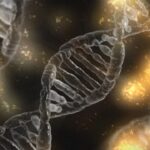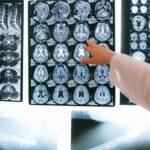 Australian Genomics is a national collaborative partnership of more than 100 organizations piloting a whole-of-system approach to integrating genomics into healthcare. In the first five years of operation, Australian Genomics has evaluated the outcomes of genomic testing in more than 5,200 individuals across 19 rare disease and cancer flagship studies. Comprehensive analyses of the health economic, policy, ethical, legal, implementation and workforce implications of incorporating genomics in the Australian context have informed evidence-based change in policy and practice, resulting in national government funding and equity of access for a range of genomic tests. Simultaneously, Australian Genomics has built national skills, infrastructure, policy, and data resources to enable effective data sharing to drive discovery research and support improvements in clinical genomic delivery. Read the full article here.
Australian Genomics is a national collaborative partnership of more than 100 organizations piloting a whole-of-system approach to integrating genomics into healthcare. In the first five years of operation, Australian Genomics has evaluated the outcomes of genomic testing in more than 5,200 individuals across 19 rare disease and cancer flagship studies. Comprehensive analyses of the health economic, policy, ethical, legal, implementation and workforce implications of incorporating genomics in the Australian context have informed evidence-based change in policy and practice, resulting in national government funding and equity of access for a range of genomic tests. Simultaneously, Australian Genomics has built national skills, infrastructure, policy, and data resources to enable effective data sharing to drive discovery research and support improvements in clinical genomic delivery. Read the full article here.
Publications
Deep next-generation proteomics and network analysis reveal systemic and tissue-specific patterns in Fabry disease
 Fabry disease (FD) is an X-linked lysosomal rare disease due to a deficiency of α-galactosidase A activity. The accumulation of glycosphingolipids mainly affects the kidney, heart, and central nervous system. Although the accumulation of undegraded substrate is considered the primary cause of FD, it is established that secondary dysfunctions at the cellular, tissue, and organ levels ultimately give rise to the clinical phenotype. To parse this biological complexity, a large-scale deep plasma targeted proteomic profiling is performed. In this report the plasma protein profiles of FD deeply phenotyped patients (n = 55) is analyzed compared to controls (n = 30) using next-generation plasma proteomics including 1463 proteins. Systems biology and machine learning approaches is used. The analysis enables the identification of proteomic profiles that unambiguously separates FD patients from controls. The findings highlight the pro-inflammatory cytokines’ involvement in FD pathogenesis along with extracellular matrix remodeling. This study shows a tissue-wide metabolic remodeling connection to plasma proteomics in FD. These results will facilitate further studies to understand the molecular mechanisms in FD to pave the way for better diagnostics and therapeutics. Read the full article here.
Fabry disease (FD) is an X-linked lysosomal rare disease due to a deficiency of α-galactosidase A activity. The accumulation of glycosphingolipids mainly affects the kidney, heart, and central nervous system. Although the accumulation of undegraded substrate is considered the primary cause of FD, it is established that secondary dysfunctions at the cellular, tissue, and organ levels ultimately give rise to the clinical phenotype. To parse this biological complexity, a large-scale deep plasma targeted proteomic profiling is performed. In this report the plasma protein profiles of FD deeply phenotyped patients (n = 55) is analyzed compared to controls (n = 30) using next-generation plasma proteomics including 1463 proteins. Systems biology and machine learning approaches is used. The analysis enables the identification of proteomic profiles that unambiguously separates FD patients from controls. The findings highlight the pro-inflammatory cytokines’ involvement in FD pathogenesis along with extracellular matrix remodeling. This study shows a tissue-wide metabolic remodeling connection to plasma proteomics in FD. These results will facilitate further studies to understand the molecular mechanisms in FD to pave the way for better diagnostics and therapeutics. Read the full article here.
 Rare diseases (RDs), more than 80% of which have a genetic origin, collectively affect approximately 350 million people worldwide. Progress in next-generation sequencing technology has both greatly accelerated the pace of discovery of novel RDs and provided more accurate means for their diagnosis. RDs that are driven by altered epigenetic regulation with an underlying genetic basis are referred to as rare diseases of epigenetic origin (RDEOs). These diseases pose unique challenges in research, as they often show complex genetic and clinical heterogeneity arising from unknown gene-disease mechanisms. Furthermore, multiple other factors, including cell type and developmental time point, can confound attempts to deconvolute the pathophysiology of these disorders. These challenges are further exacerbated by factors that contribute to epigenetic variability and the difficulty of collecting sufficient participant numbers in human studies. However, new molecular and bioinformatics techniques will provide insight into how these disorders manifest over time. Read the full article here.
Rare diseases (RDs), more than 80% of which have a genetic origin, collectively affect approximately 350 million people worldwide. Progress in next-generation sequencing technology has both greatly accelerated the pace of discovery of novel RDs and provided more accurate means for their diagnosis. RDs that are driven by altered epigenetic regulation with an underlying genetic basis are referred to as rare diseases of epigenetic origin (RDEOs). These diseases pose unique challenges in research, as they often show complex genetic and clinical heterogeneity arising from unknown gene-disease mechanisms. Furthermore, multiple other factors, including cell type and developmental time point, can confound attempts to deconvolute the pathophysiology of these disorders. These challenges are further exacerbated by factors that contribute to epigenetic variability and the difficulty of collecting sufficient participant numbers in human studies. However, new molecular and bioinformatics techniques will provide insight into how these disorders manifest over time. Read the full article here.
 Aicardi-Goutières syndrome (AGS) is a rare genetic disorder involving the central nervous system and autoimmune abnormalities, leading to severe intellectual and physical disability with poor prognosis. AGS has a phenotype similar to intrauterine viral infection, which often leads to delays in genetic counseling. In this study, a case with a prenatal diagnosis of AGS is reported. The first fetal ultrasound detects bilateral lateral ventricle cystic structures, and fetal MRI is performed to identify other signs. The right parietal lobe signal shows cerebral white matter abnormalities, and fetal brain development level is lower than that of normal fetuses of the same gestational age. Whole-exome sequencing is performed and the final comprehensive diagnosis is AGS1. In this article, also the previous literature for possible phenotypes in the fetus is preformed and the conclusion that microcephaly and intrauterine growth retardation may be the first and most important markers of the intrauterine phenotype of AGS is made. Read the full article here.
Aicardi-Goutières syndrome (AGS) is a rare genetic disorder involving the central nervous system and autoimmune abnormalities, leading to severe intellectual and physical disability with poor prognosis. AGS has a phenotype similar to intrauterine viral infection, which often leads to delays in genetic counseling. In this study, a case with a prenatal diagnosis of AGS is reported. The first fetal ultrasound detects bilateral lateral ventricle cystic structures, and fetal MRI is performed to identify other signs. The right parietal lobe signal shows cerebral white matter abnormalities, and fetal brain development level is lower than that of normal fetuses of the same gestational age. Whole-exome sequencing is performed and the final comprehensive diagnosis is AGS1. In this article, also the previous literature for possible phenotypes in the fetus is preformed and the conclusion that microcephaly and intrauterine growth retardation may be the first and most important markers of the intrauterine phenotype of AGS is made. Read the full article here.
 Huntington’s disease (HD) is a rare neurodegenerative disorder with no disease modifying therapeutics. HD is characterized by extensive neuronal loss and is caused by the inherited expansion of the huntingtin (HTT) gene that encodes a toxic protein. Current HD therapeutics only offer symptomatic relief. Infact, Food and Drug Administration (FDA) approved two synthetic small-molecule inhibitors, tetrabenazine and deutetrabenazine, for managing HD chorea and various other diseases in clinical trials. Therefore, the landscape of drug discovery programs for HD is evolving. Likewise, numerous natural products are being evaluated at different stages of clinical development and have shown the potential to ameliorate HD pathology. The inherent anti-inflammatory and antioxidant properties of natural products mitigate the mHTT-induced oxidative stress and neuroinflammation, improve mitochondrial functions, and augment the anti-apoptotic and pro-autophagic mechanisms for increased survival of neurons in HD. This article discusses HD pathogenesis and summarizes the anti-HD clinical and pre-clinical natural products, focusing on their therapeutic effects and neuroprotective mechanisms. Read the full article here.
Huntington’s disease (HD) is a rare neurodegenerative disorder with no disease modifying therapeutics. HD is characterized by extensive neuronal loss and is caused by the inherited expansion of the huntingtin (HTT) gene that encodes a toxic protein. Current HD therapeutics only offer symptomatic relief. Infact, Food and Drug Administration (FDA) approved two synthetic small-molecule inhibitors, tetrabenazine and deutetrabenazine, for managing HD chorea and various other diseases in clinical trials. Therefore, the landscape of drug discovery programs for HD is evolving. Likewise, numerous natural products are being evaluated at different stages of clinical development and have shown the potential to ameliorate HD pathology. The inherent anti-inflammatory and antioxidant properties of natural products mitigate the mHTT-induced oxidative stress and neuroinflammation, improve mitochondrial functions, and augment the anti-apoptotic and pro-autophagic mechanisms for increased survival of neurons in HD. This article discusses HD pathogenesis and summarizes the anti-HD clinical and pre-clinical natural products, focusing on their therapeutic effects and neuroprotective mechanisms. Read the full article here.

Prader-Willi syndrome (PWS) is a rare and complex genetic disease, with numerous implications on metabolic, endocrine, neuropsychomotor systems, and with behavioral and intellectual disorders. Rare disease patient registries are important scientific tools to collect clinical and epidemiologic data, to assess the clinical management including the diagnostic delay, to improve patients’ care and to foster research to identify new therapeutic solutions. The European Union has recommends the implementation and use of registries and databases. The main aims of this paper are to describe the process of setting up the Italian PWS register, and to illustrate our preliminary results. The Italian PWS registry was established in 2019 with the aims to describe the natural history of the disease, to determine clinical effectiveness of health care services, to measure and monitor quality of care of patients. Information from six different variables are included and collected into this registry: demographics, diagnosis and genetics, patient status, therapy, quality of life and mortality. The analyses of these six variables allowed to highlight important clinical aspects and natural history of PWS useful to inform future actions to be taken by national health care services and health professionals. Read the full article here.
 Urbach-Wiethe disease is an extremely rare genetically-based syndrome which usually leads to dermatological and neurological changes. Neurologically, the amygdaloid region is primarily bilaterally affected. Therefore, several functions modulated by the amygdala are changed in patients with Urbach-Wiethe disease. As the neurological alterations evolve only gradually, it is particularly important to determine the cognitive and brain status of a juvenile. In this case a patient is seen briefly at age 9 and tested neuropsychologically at age 19; furthermore, computer tomography and magnetic resonance imaging of his head is done. There are no important abnormalities in the brain, which is unusual in the light of previous data from other patients. On the cognitive level, the patient is generally within normal limits. However, he has mild problems in attention and concentration, and more prominent problems in emotional processing domain, and in personality dimensions. It is concluded that amygdala calcifications in Urbach-Wiethe disease take place progressively-possibly underpinned by genetic and gender variables; this can subsequently allow psychosocial-social factors (such a proper education and socialization) and biological factors (compensatory neuroplasticity) to retard and diminish the development of socio-emotional and cognitive deteriorations. Read the full article here.
Urbach-Wiethe disease is an extremely rare genetically-based syndrome which usually leads to dermatological and neurological changes. Neurologically, the amygdaloid region is primarily bilaterally affected. Therefore, several functions modulated by the amygdala are changed in patients with Urbach-Wiethe disease. As the neurological alterations evolve only gradually, it is particularly important to determine the cognitive and brain status of a juvenile. In this case a patient is seen briefly at age 9 and tested neuropsychologically at age 19; furthermore, computer tomography and magnetic resonance imaging of his head is done. There are no important abnormalities in the brain, which is unusual in the light of previous data from other patients. On the cognitive level, the patient is generally within normal limits. However, he has mild problems in attention and concentration, and more prominent problems in emotional processing domain, and in personality dimensions. It is concluded that amygdala calcifications in Urbach-Wiethe disease take place progressively-possibly underpinned by genetic and gender variables; this can subsequently allow psychosocial-social factors (such a proper education and socialization) and biological factors (compensatory neuroplasticity) to retard and diminish the development of socio-emotional and cognitive deteriorations. Read the full article here.
 Mayer-Rokitansky-Kuster-Hauser (MRKH) syndrome is a complex disorder of the female reproductive system that results in an absent uterus and vagina. MRKH syndrome can be an isolated anomaly (typical) or accompanied by other organ anomalies (atypical). Due to the similarity of symptoms with other congenital gynecological diseases, imaging modalities remain the most important tools in establishing the diagnosis by visualizing internal genital and detecting possible organ malformations. A very rare case of a female with primary amenorrhea is reported. Pelvic magnetic resonance imaging (MRI) show the absence of a uterus and vagina with possible Mullerian remnants, as well as an incidental finding of a right ectopic kidney. Abdominal ultrasonography and chest X-ray show that the patient also has situs inversus totalis. MRKH syndrome may be associated with situs inversus totalis due to possible early embryologic malformations causing both conditions; however, the exact mechanism is still unknown. This report should serve as a more recent attempt to question whether situs inversus totalis is related to MRKH and to emphasize the importance of imaging modalities, especially MRI, in establishing the diagnosis of MRKH syndrome and the associated malformations. Read the full article here.
Mayer-Rokitansky-Kuster-Hauser (MRKH) syndrome is a complex disorder of the female reproductive system that results in an absent uterus and vagina. MRKH syndrome can be an isolated anomaly (typical) or accompanied by other organ anomalies (atypical). Due to the similarity of symptoms with other congenital gynecological diseases, imaging modalities remain the most important tools in establishing the diagnosis by visualizing internal genital and detecting possible organ malformations. A very rare case of a female with primary amenorrhea is reported. Pelvic magnetic resonance imaging (MRI) show the absence of a uterus and vagina with possible Mullerian remnants, as well as an incidental finding of a right ectopic kidney. Abdominal ultrasonography and chest X-ray show that the patient also has situs inversus totalis. MRKH syndrome may be associated with situs inversus totalis due to possible early embryologic malformations causing both conditions; however, the exact mechanism is still unknown. This report should serve as a more recent attempt to question whether situs inversus totalis is related to MRKH and to emphasize the importance of imaging modalities, especially MRI, in establishing the diagnosis of MRKH syndrome and the associated malformations. Read the full article here.
Gastrointestinal Manifestations and Low- FODMAP Protocol in a Cohort of Fabry Disease Adult Patients
 Fabry disease (FD) is an X-linked lysosomal disorder caused by α-galactosidase A enzyme deficiency. Gastrointestinal (GI) manifestations are reported in FD with a prevalence of about 50%, usually treated by Enzymatic Replacement Therapy (ERT) or oral treatment. Since FODMAPs (Fermentable Oligosaccharides, Disaccharides, Monosaccharides, and Polyols) can be involved in GI manifestations and dysbiosis in FD patients, a low-FODMAP diet could represent an alternative adjunctive treatment in FD subjects, as well as being useful for reducing symptoms in Irritable Bowel Syndrome (IBS). Data from 36 adult FD patients followed at the Inherited Metabolic Rare Diseases Adult Centre of the University Hospital of Padova is retrospectively assessed. In symptomatic patients, the low-FODMAP diet is proposed in order to improve GI manifestations. Severe or moderate GI symptoms are to be found in 61.1% of patients, with no correlation to the therapy in use, and significantly more severe in the classical form of FD. The low-FODMAP diet significantly improves indigestion, diarrhoea, and constipation. This dietetic protocol seems to have a positive impact on intestinal symptoms, by identifying and reducing the intake of the foods most related to the onset of disorders and improving the clinical manifestations. A low-FODMAP diet may be an effective alternative approach to improve intestinal manifestations and quality of life, and nutrition can play an important role in the multidisciplinary care of patients with FD. Read the full article here.
Fabry disease (FD) is an X-linked lysosomal disorder caused by α-galactosidase A enzyme deficiency. Gastrointestinal (GI) manifestations are reported in FD with a prevalence of about 50%, usually treated by Enzymatic Replacement Therapy (ERT) or oral treatment. Since FODMAPs (Fermentable Oligosaccharides, Disaccharides, Monosaccharides, and Polyols) can be involved in GI manifestations and dysbiosis in FD patients, a low-FODMAP diet could represent an alternative adjunctive treatment in FD subjects, as well as being useful for reducing symptoms in Irritable Bowel Syndrome (IBS). Data from 36 adult FD patients followed at the Inherited Metabolic Rare Diseases Adult Centre of the University Hospital of Padova is retrospectively assessed. In symptomatic patients, the low-FODMAP diet is proposed in order to improve GI manifestations. Severe or moderate GI symptoms are to be found in 61.1% of patients, with no correlation to the therapy in use, and significantly more severe in the classical form of FD. The low-FODMAP diet significantly improves indigestion, diarrhoea, and constipation. This dietetic protocol seems to have a positive impact on intestinal symptoms, by identifying and reducing the intake of the foods most related to the onset of disorders and improving the clinical manifestations. A low-FODMAP diet may be an effective alternative approach to improve intestinal manifestations and quality of life, and nutrition can play an important role in the multidisciplinary care of patients with FD. Read the full article here.
 Urinary and serological markers play an essential role in the diagnostic process of autoimmune diseases. However, to date, specific and reliable biomarkers for diagnosing Behçet’s disease (BD) are still lacking, negatively affecting the management of these patients. To analyze the currently available literature on serological and urinary BD biomarkers investigated in the last 25 years, a systematic literature review is performed. Most articles reported an increase in inflammatory markers and pro-oxidant molecules, with a decrease in antioxidants. Despite the vast number of investigated markers, existing evidence indicates a persistent gap in BD diagnostic/prognostic indices. While new steps have been taken in the direction of pathogenesis and disease monitoring, international efforts for the search of a diagnostic marker for BD are still needed. Read the full article here.
Urinary and serological markers play an essential role in the diagnostic process of autoimmune diseases. However, to date, specific and reliable biomarkers for diagnosing Behçet’s disease (BD) are still lacking, negatively affecting the management of these patients. To analyze the currently available literature on serological and urinary BD biomarkers investigated in the last 25 years, a systematic literature review is performed. Most articles reported an increase in inflammatory markers and pro-oxidant molecules, with a decrease in antioxidants. Despite the vast number of investigated markers, existing evidence indicates a persistent gap in BD diagnostic/prognostic indices. While new steps have been taken in the direction of pathogenesis and disease monitoring, international efforts for the search of a diagnostic marker for BD are still needed. Read the full article here.
